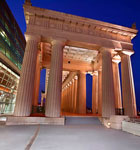While green building has grown in popularity in recent years, there is a big difference between having energy-efficient systems and actually operating under sustainable best practices. With its 8,000 acres of parkland, 26 miles of lakefront property, 250 field houses, and the popular Soldier Field—home of the Chicago Bears—the Chicago Parks District is a prime example of an organization that has enjoyed documentable success deploying and maintaining green systems.
“One of our initiatives is to be the greenest park district in the nation and a forerunner as we continue to embrace sustainable practices,” says Mike Kelly, the Chicago Parks District’s interim superintendent and CEO. “As a result, we are at the point that all new building projects include a LEED component. When people enter one of our buildings with the bamboo floors and energy-efficient systems, they know something is different, and it creates an opportunity for our structures to serve as public education systems.”
Probably the most visible of the Chicago Parks District’s projects has been the LEED-EB renovation and rejuvenation that has taken place over the past seven years at Soldier Field. Some of the sustainable operations initiatives included replacing traditional external bulbs with LED lighting, installing a building-automation system with occupancy sensors, staggering start-ups of mechanical equipment and field lighting, and purchasing water-saving faucets and toilets. An unlikely recipient of the green makeover was the north garage, which now boasts a green roof and electric-vehicle charging stations, provided in conjunction with Carbon Day and available for free use. Soldier Field also has pioneered an aggressive recycling program in partnership with Allied Waste.

“We also recycle our field sod to divert millions of pounds from the landfill each year,” Soldier Field director of operations Michael Ortman says. “We are also in the process of replacing the traditional 100-watt fixtures that light up the stadium columns with 40-watt LEDs. In addition to saving us money, [it will also enable us] to use different colors during the holidays. We have done this in the past with gels and extra labor, but now we have the ability to do so without extra expense.”
According to Ortman, education is a challenge—especially when so many people are involved—but the results are well worth the effort. “It has been a four-year process [that] has resulted in a lot of learning,” he says. “This is tough to accomplish with such a large facility, but as we have progressed, people have continued to embrace the principles. For instance, after each Chicago Bears game we [have] increased plastics recycling from 30 cubic yards to 60 cubic yards, … added an additional 20 cubic yards of aluminum, and cardboard recycling is up 50 percent.”
In keeping with its green-building commitment, the Chicago Parks District also recently built two LEED Gold beach houses and two LEED Gold field houses. In addition, the district recently opened its own biodiesel plant. Overall, in the past 18 months, the Chicago Parks District has spent close to $30 million on green retrofits—mainly on boiler replacements and the development of an enterprise system that allows HVAC engineers to control systems remotely.
With a $35 million capital budget, the biggest challenge is finding funds to pursue green projects, Kelly says. “Fortunately, through bonds, grants, and donations, we have found ways to fund our green projects,” he says. “When [we] do these initiatives, we are saving money; improving the physical plant; and living up to our mantra of being open, active, green, and connected.”

